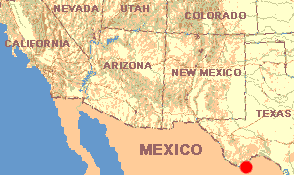BIRD LIST #2: Big Bend as Spring Begins
 February 17, 1988
February 17, 1988
TEXAS: Brewster County
Big Ben National Park; elevation about 2800
feet. Three-hour, early-morning hike between the primitive campsites called Willow Tank
and Ernst Tinaja. The landscape consists of low, rocky hills vegetated with Creosote-bush,
Sotol, grasses, Purple Cenizo and Candelilla.
If during this three-hour walk you had been with me, these are the bird species you would have seen:
BIRDLIST #2: THE DESERT IN WINTER
Scaled Quail
Chihuahuan Raven
Cactus Wren
Curve-billed Thrasher
Loggerhead
Shrike
Pyrrhuloxia
Black-throated Sparrow
This is the smallest number of birds I've ever seen
after three hours of watching. It's because now we're in a habitat so arid that only
species that are "desert specialists" can survive. All seven species listed
above are non-migrating permanent residents, and all were spotted in the uplands between
springs. Around the springs, among copses of small willows and mesquites, other bird
species do appear -- Ruby-crowned
Kinglets, Northern Mockingbirds, Bewick's Wrens,
House
Finches, White-crowned Sparrows, Green-tailed
Towhees...
Of the seven birds in the list, Black-throated
Sparrows were the most conspicuous, often appearing in flocks of fifteen to
twenty individuals. Back at K-Bar on recent afternoons as I sat reading in Henry, a
certain Black-throated Sparrow often perched atop Henry's open door, not three feet from
me. They are attractive little birds.
During my walks often I hear a couple of high-pitched notes, which
I've discovered to be the warning calls being made by nervous Scaled
Quails. Soon after such warnings, usually a covey of thirty to fifty quail
explode into the air. When they land a safe distance from me, each bird runs -- not hops
or flits -- to a hiding place. At K-Bar, each afternoon a flock of fifteen congregates to
peck in the dust where recently a camping party tethered its horses, leaving seed among
the hay and dried horse manure. Sometimes not fifteen feet from Henry, with me inside, the
quail gather in a tight circle in the dust, with their heads pointing outwards, and then
peck at such a frenetic, almost comical pace that they kick up dense dust-clouds. Each
bird bears a conspicuous, pale head-crest that in late-afternoon light glows brightly,
conveying to each bird the appearance of wearing a crown. What handsome, good-natured
birds these are.
Yesterday for nearly two minutes I watched a Loggerhead
Shrike chase a smaller bird, probably a Black-throated Sparrow.
The two birds flew high into the sky and zig-zagged wonderfully and desperately, finally
disappearing beyond my range of vision. Despite this enmity between the two species, this
morning I've seen several shrikes perched on old flower-stalks of Sotol
and Lechuguilla, and a couple of times perched nearby were sparrows.
Perhaps shrikes attack only those birds whom they sense to be enfeebled, and the healthy
sparrows behave accordingly.
"Chihuahuan
Raven" is the new name for the bird that for years I've called
"White-necked Raven." This species is smaller than the Common Raven, has a
higher-pitched voice, and is something of a Southwestern specialty. Often I've seen it in
northern Mexico's desert. Though the Chihuahuan Raven is completely black, sometimes it
bends its head over in such a way that a few white feathers across the upper back become
visible. This bird's Latin name is Corvus cryptoleucus.Corvus is the name the
ancient Latin-speakers used for crows and ravens. The cryptois is from the Greek
meaning "concealed," and leucusis from the Greek meaning
"white." It's the raven with concealed white feathers.
 February 17, 1988
February 17, 1988